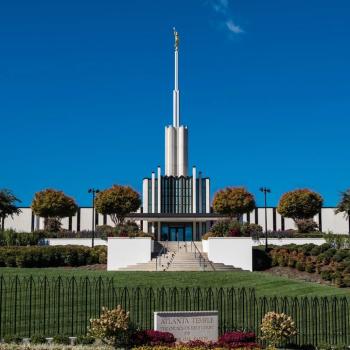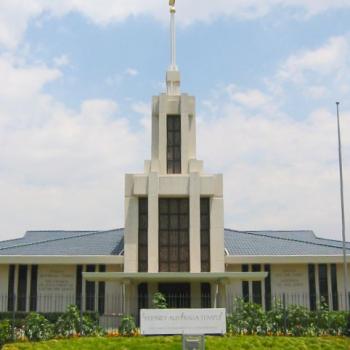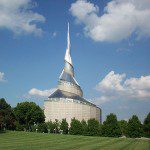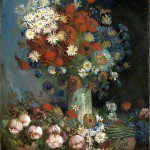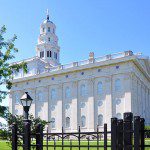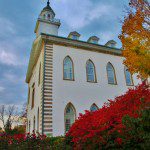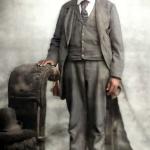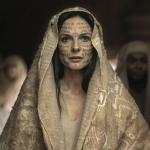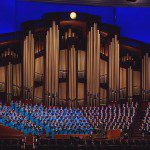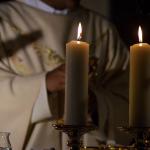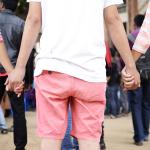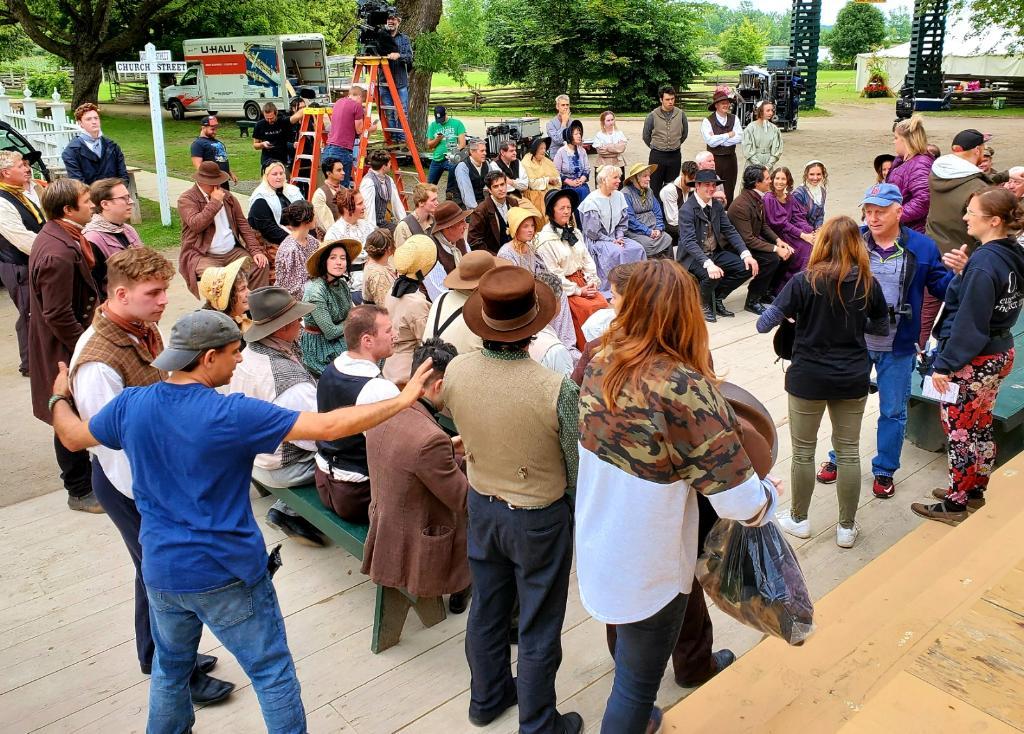
(Photo kindly provided by James Jordan)
I’ve long had a particular interest in the Witnesses to the Book of Mormon. (The Interpreter Foundation’s Witnesses film project is an obvious outgrowth of that interest.) Accordingly, I also have an interest in criticisms of the Witnesses. This interest forms the background of a column that I published in the Deseret News back on 9 June 2011:
Though little remembered today, James Jesse Strang campaigned seriously to lead the LDS Church after Joseph Smith’s 1844 assassination.
When the general membership rejected the obscure new convert’s claim that a secret letter had appointed him as Joseph Smith’s successor, Strang started his own sect, ultimately headquartered on Beaver Island, Mich. Like Joseph, he eventually claimed to have translated ancient metal plates and provided 11 corroborating eyewitnesses.
By 1856, when he himself was murdered, he had several thousand followers, including members of Joseph Smith’s family, former apostles and Book of Mormon witnesses.
That some Book of Mormon witnesses credited Strang argues for their sincerity, incidentally: Had they been knowing perpetrators of a fraud with Joseph Smith, they would likely have been far more skeptical of Strang.
But does the fact that Strang had witnesses like Joseph’s mean that, for consistency’s sake, modern believers in Mormonism must either accept Strang’s claims or reject both Joseph and Strang?
No. Because the two sets of witnesses and their experiences were very different.
The two sets of inscribed plates that Strang claimed to have found in Wisconsin and Michigan beginning in 1845 almost certainly existed. Milo Quaife’s early, standard biography of Strang reflects that, while Strang’s angelic visitations “may have had only a subjective existence in the brain of the man who reported them, the metallic plates possessed a very material objective reality.”
And they were almost certainly forgeries.
The first set, the three “Voree” or “Rajah Manchou” plates, were dug up by four “witnesses” whom Strang had taken to the plates’ burial place. Illustrated and inscribed on both sides, the Rajah Manchou plates were roughly 1.5 by 2.75 inches in size — small enough to fit in the palm of a hand or to carry in a pocket.
Among the many who saw them was Stephen Post, who reported that they were brass and, indeed, that they resembled the French brass used in familiar kitchen kettles. “With all the faith & confidence that I could exercise,” he wrote, “all that I could realize was that Strang made the plates himself, or at least that it was possible that he made them.” One source reports that most of the four witnesses to the Rajah Manchou plates ultimately repudiated their testimonies.
The 18 “Plates of Laban,” likewise of brass and each about 7.5 by 9 inches, were first mentioned in 1849 and were seen by seven witnesses in 1851. These witnesses’ testimony was published as a preface to “The Book of the Law of the Lord,” which Strang said he derived from the “Plates of Laban.” (He appears to have begun the “translation” at least as early as April 1849. An 84-page version appeared in 1851; by 1856, it had reached 350 pages.) Strang’s witnesses report seeing the plates, but mention nothing miraculous. Nor did Strang supply any additional supporting testimony comparable to that of the Three Witnesses to the Book of Mormon.
One of the witnesses to the “Plates of Laban,” Samuel P. Bacon, eventually denied the inspiration of Strang’s movement and denounced it as mere “human invention.” Another, Samuel Graham, later claimed that he had actually assisted Strang in the creation of the plates.
“We can hardly escape the conclusion,” writes Quaife, “that Strang knowingly fabricated and planted them for the purpose of duping his credulous followers” and, accordingly, that “Strang’s prophetic career was a false and impudent imposture.” A more recent biographer, Roger Van Noord, concludes that “based on the evidence, it is probable that Strang — or someone under his direction — manufactured the letter of appointment and the brass plates to support his claim to be a prophet and to sell land at Voree. If this scenario is correct, Strang’s advocacy of himself as a prophet was more than suspect, but no psychological delusion.”
Thus, Strang’s plates were much less numerous than those of the Book of Mormon, his witnesses saw nothing supernatural and his translation required the better part of a decade rather than a little more than two months. (Quite unlike the semi-literate Joseph Smith, Strang was well-read. He had been an editor and lawyer before his involvement with Mormonism.) Perhaps most strikingly, unlike the witnesses to the Book of Mormon, some (at least) of Strang’s witnesses later denied their testimonies.
The contrasts work very much in Joseph Smith’s favor.
For obscure reasons, this nine-year-old column has suddenly come into prominence as a parade example of my supposed contempt for religious views that differ from mine. James J. Strang still has a few hundred followers today and one of them has recently taken rather angry exception to what I wrote back in 2011. Unsurprisingly, a small chorus of my most implacable critics, seeing his criticism, has now joined in as enthusiastic back-up singers.
My “Strangite” critic says that my column is inaccurate. That’s conceivable, I suppose. I don’t pretend to expertise on James Strang, nor even to any particular interest in him or his movement (let alone any ill-will or malice toward it), so I relied, in writing the column, on the best scholarship that I knew. I went, for example, to Milo Quaife’s The Kingdom of Saint James: A Narrative of the Mormons (New Haven and London: Yale University Press, 1930). Quaife (1880-1959) was a historian of Michigan and the Great Lakes region who taught at Wayne State University and the University of Detroit and directed the Wisconsin State Historical Society. I also consulted Roger Van Noord’s King of Beaver Island: The Life and Assassination of James Jesse Strang (Urbana and Chicago: University of Illinois Press, 1988). Van Noord is a journalist and biographer based in Wisconsin. My friend James Allen, who formerly served as assistant historian for the Church of Jesus Christ of Latter-day Saints and as Lemuel H. Redd Professor of Western History at Brigham Young University, reviewed Van Noord’s Strang biography in 1991. It “brings admirable balance” to its subject, he said. Contrary to my “Strangite” critic’s claim, I didn’t pick “the worst quotes from scholars.” I didn’t cherry pick offensive lines. I simply chose passages that were relevant to my point — which was focused on defending the claims of the Book of Mormon Witnesses — from reputable scholars on the subject.
Of course, if there is better scholarship on James Jesse Strang of which I should be aware, I’ll be sure to have a look at it before I write on the topic again — which, honestly, I may or may not ever do. Of academic disputes, obviously, there is no end.
What most fascinates me, though, is the fact that my little column above is now being described as “bigoted,” “a hit job,” “unkind,” “purposely hateful,” “carefully orchestrated,” “designed to malign,” “mean-spirited,” a “one-sided hit piece,” “deceit,” “bilious,” “a one-sided hit job,” “deception,” “disrespectful,” “bullying,” “lying,” an act of “hate,” “spiteful,” “mean,” “nasty,” “desperate,” using the “tactics” of a “political hack,” and a perfect illustration of how I “just [don’t] give a damn” about “collateral damage” or the “feelings” of others.
This column of mine is the kind of thing that, if only they were aware of it and recognized it for the evil thing that it is, would impel the leaders of Brigham Young University and of the Church of Jesus Christ of Latter-day Saints to condemn me and the editors of the Deseret News to cast me out in righteous disgust.
Well, the column is there for you to read, if you choose. Feel free to form your own judgment.



